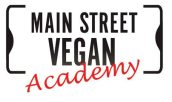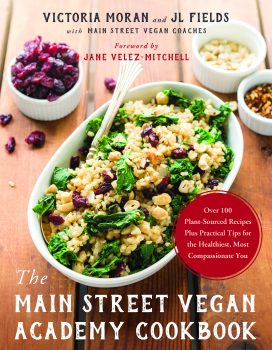I am borderline-obsessed with vegans feeling good. This is different from the emphasis physicians in our movement place on keeping us healthy. They’re looking at lab results and mortality risk — important, to be sure — but the ex-vegans I run into didn’t leave the fold because their blood sugar shot up or they were diagnosed with some pathology. They just didn’t feel right. Although I realize that extenuating factors – e.g., a new boyfriend – may have figured in, what these people report is either a constellation of minor but troubling symptoms, or a vague, general malaise. I could relate. Then I heard a word that made quite a bit add up: histamine.
Sure, I’d heard of antihistamine medication for allergy symptoms, but in 2014, coming back from the Western New York VegFest with raw food writer Karen Ranzi, she was on PubMed reading articles in the scientific literature about something called histaminosis, symptoms that went far beyond the itchy eyes and sneezes of hay fever or a reaction to animal dander. This is accepted in Europe as a condition to be dealt with, but virtually unknown here. This list of symptoms included:
- Red wine headache
- Low blood pressure
- Difficulty regulating body temperature
- Cold feet and/or hands
- Nasal congestion, runny nose
- Swollen tongue
- Painful ear cartilage after sleeping
- Eczema
- Hives (urticaria)
- Frozen shoulder
- Tinnitis
- Itchy scalp
- Shortness of breath, chest pain, with no heart disease diagnosis
- Cluster headache
- Digestive disorders, constipation
- Hair loss
These caught my attention. Despite my always normal labs, I had experienced an uncanny array of these symptoms. Wine makes me sick. Any alcohol does. I suffered through frozen shoulder (adhesive capsulitis) in 2003 – eight months of hell – and a less harrowing repeat in the other shoulder in 2007. I’d dealt with cold feet for years despite countless thyroid tests, all negative. Even some of the weirder symptoms – waking up with a sore outer ear – I’d been through and doctors had written them off.
Karen showed me citations that, in addition to obvious symptoms such as those listed, more subtle indices of a possible histamine reaction include a sense of fatigue or slowing down, coming about half an hour after eating. This can include a foggy feeling, a downturn of personality, a slowing of one’s walking pace. People report sniffling, coughing, nasal congestion, a slight swelling of the throat or tongue, a sudden sense of agitation or nervousness, or a poor reaction to exercise, such as dizziness, or more exhaustion or shortness of breath than the activity warrants.
 Some of these hit close to home, too, but “the cure” seemed like too much to take on. It involved cutting out a vast number of foods, many of them really nutritious. I was sufficiently curious to book a session with a UK health coach who specialized in histamine disorders and she shared with me that the process wasn’t as restrictive as I’d feared. Unlike an allergy, she explained, in which eating a peanut causes someone’s throat to close up, or eating strawberry causes the person to break out in hives, this is more of a tolerance issue. When you’re consuming a great many histamine-containing or histamine- provoking foods, perhaps combined with exposure to airborne allergens, and all this happening at a time when you’re especially stressed or short on sleep, the combination is likely to result in a histamine reaction for a sensitive person.
Some of these hit close to home, too, but “the cure” seemed like too much to take on. It involved cutting out a vast number of foods, many of them really nutritious. I was sufficiently curious to book a session with a UK health coach who specialized in histamine disorders and she shared with me that the process wasn’t as restrictive as I’d feared. Unlike an allergy, she explained, in which eating a peanut causes someone’s throat to close up, or eating strawberry causes the person to break out in hives, this is more of a tolerance issue. When you’re consuming a great many histamine-containing or histamine- provoking foods, perhaps combined with exposure to airborne allergens, and all this happening at a time when you’re especially stressed or short on sleep, the combination is likely to result in a histamine reaction for a sensitive person.
I still wasn’t sufficiently motivated to alter my diet. But this July, at Vegan Summerfest, I got sick. It was an odd sort of cold or flu that affected my throat and rendered me with full-out, no-voice laryngitis, post-nasal drip, and a cough, especially at night. After it persisted for ten days, I went to my primary care doc. He prescribed an antibiotic. I’m not a fan of prescription drugs, but I missed talking and took the first dose. Within a couple of hours, my back was itching and I had four large, red hives – something I hadn’t had since age four when I binged on late summer tomatoes from my grandparents’ garden.
The doctor told me to discontinue the antibiotic, which I did, but the next day there were more hives,  and the day after that. Sometimes a day or even two would pass without developing any more, but then one or two would pop up — swollen, feverish, itchy. My doctor wanted to do a course of steroids. I wasn’t interested. I remembered the Fat, Sick & Nearly Dead documentary and Joe Cross’s chronic urticaria. I was scared. I also remembered the histamine connection. This time, I was ready to do something.
and the day after that. Sometimes a day or even two would pass without developing any more, but then one or two would pop up — swollen, feverish, itchy. My doctor wanted to do a course of steroids. I wasn’t interested. I remembered the Fat, Sick & Nearly Dead documentary and Joe Cross’s chronic urticaria. I was scared. I also remembered the histamine connection. This time, I was ready to do something.
An actual medical diagnosis for histamine intolerance is difficult to get. Most physicians in the U.S. are not familiar with it, so I was willing to simply try the dietary changes on my own. I pulled up my notes from the coaching session and the books on the subject I’d purchased at that time. I immediately made modifications to my diet, and the skin reactions stopped.
As I list the foods that people who suspect histamine sensitivity may want to avoid or deemphasize, I want to be clear that these are not blanket recommendations for the general population – or, if you’re a health coach or a vegan lifestyle coach, they’re not recommendations for your average client. I have no intention of being a killjoy or an orthorexic who is afraid of all manner of edibles. All the foods on this list are blessings from nature’s bounty that most people can consume with impunity. For someone suffering through the symptoms I’ve noted, however, leaving potentially problematic foods off for awhile, and consuming them less often going forward, doesn’t feel like deprivation. It feels like relief.
The list that follows is for vegans. Many animal foods are histamine promoters, but we’re not eating those anyway. Some people have success by assiduously avoiding suspect foods for a period of time, say, twenty-one to thirty days, and then adding them back one at at time, noting any reactions. I didn’t do a total elimination myself. I’ve simply focused on histamine-free and histamine-healing foods – those below in boldface are especially helpful – and consume those in the “deemphasize” column with less frequency and in smaller amounts.
If you suspect histamine intolerance:
First, avoid any foods which you know – or strongly sense – are problematic for you. You live in your body and, to a large extent, you know which foods agree with you and which ones don’t.
Second, avoid, or consume with extreme caution, anything spoiled, rotten, or fermented, or anything in the yeast or fungus families — tamasic foods, for any yogis reading this). Included in this category are:
- Alcoholic beverages, especially red wine; for very sensitive people, even kombucha, or the alcohol in vanilla extract might be problematic. (Some vintners in Italy and Germany have developed low-histamine wines.)
- The bruised parts of bananas, apples, and pears
- Fermented cheeses
- Yogurt
- Sauerkraut, kimchi
- Fermented soy products such as tempeh, miso, soy sauce (Bragg’s Aminos is not fermented)
- Yeast breads, nutritional yeast
- Mushrooms
Otherwise, emphasize/deemphasize as follows:
Vegetables and greens
Emphasize:
- Pea sprouts (see below)
- Pea
- Carrots
- Radishes

- Cabbage-family vegetables
- Cucumber
- All greens except spinach
- String beans
- Asparagus
- Onions (these contain quercitin, a natural antihistamine with the ability to prevent immune cells from releasing histamine)
- Garlic
- Sea vegetables
- Winter squash
- Zucchini
Deemphasize:
- White potatoes
- Tomatoes (green and yellow tomatoes are best)
- Eggplant
- Spinach
- Okra
Fruits
Emphasize:
- Apples (apples inhibit the release of histamines from mast cells)
- Pomegranates (like apples, pomegranates and pomegranate juice inhibit histamine release and modulate inflammatory reactions, thus easing allergy symptoms)
- Peaches
- Pears
- Nectarines
- Blueberrries
- Blackberries
- Cranberries
- Persimmons
- Figs
- Melons
- Mangoes
Deemphasize:
- Citrus (some lemon in food prep should be okay)
- Pineapple
- Strawberries
- Raspberries
- Bananas
- Dried fruit
- Avocado
Grains
Emphasize:
- Rice, especially black rice and red rice
- Millet
- Quinoa
- Oats
- Spelt and “ancient” wheat strains, if you’re not gluten-sensitive
Deemphasize:
- Yeast breads
Legumes
Emphasize:
- Lentils
- Chickpeas
- Black beans
- White beans
- Mung beans
- Split peas
Deemphasize:
- Red beans
- Kidney beans
Nuts and seeds
Emphasize:
- Flaxseed (the ALA these — and to a lesser extent chia and hemp seeds — contain have antihistamine and anti-inflammatory properties)
- Chia seeds
- Hemp seeds
- Sunflower seeds
- Almonds
- Hazelnuts
- Pecans
- Macadamia nuts
- Coconut
- Tiger nuts
Deemphasize:
- Walnuts
- Peanuts
Beverages
Emphasize:
- Water, sparkling water, cucumber-infused water
- Green tea
- White tea
- Herbal teas
- Nettle tea (nettles are a natural antihistamine)
- Fresh juices, no spinach, minimal lemon
- Coconut water
- Coffee
Deemphasize:
- Wine, beer, and liquor
- Black tea
Condiments, seasonings, supplements
- Umeboshi plum paste (substitute for lemon, vinegar)
- Pomegranite juice (substitute for lemon, vinegar)
- Salt of your choice
- All sweeteners except white sugar
- Olive oil (contains oleic acid which helps DAO into the bloodstream, degrading histamines and relieving symptoms)
- Macadamia nut oil, coconut oil, organic canola oil
- Spices of all kinds with an emphasis on cardamom (some experts recommend avoiding cinnamon, chili powder, cloves, anise, curry powder, and cayenne for the initial 3-4-week detox period)
- Algae-based EPA/DHA (omega-3) supplements (these essential fatty acids have both antihistamine and anti-inflammatory properties)
- Bioflavonoid supplements
Deemphasize:
- Nutritional yeast
- Vinegar (Balsamic vinegar especially; apple cider vinegar works well for some histamine-sensitive people)
- Products containing vinegar, such as ketchup, pickles, vinaigrette dressings, mayonnaise
- White sugar
- Chocolate shows up on most “avoid” lists, but my coach believes that organic chocolate, especially raw cacao, is not problematic
To summarize:
Most people feel amazing when they go vegan. If you run into someone who doesn’t and their doctor can find nothing wrong, there are plenty of options to pursue before they abandon veganism. Gluten may be an issue, or some other sensitivity. B12 could be a problem. Maybe the person simply isn’t getting enough calories. Or perhaps looking at a low-histamine diet would help. It’s definitely helped me.
* * *
If you’re interested in learning more, here is a post on this subject from another vegan blogger, Randi Tisdall of BeautifullyBohemian.com.
And here is the Facebook page of the coach I consulted, Yasmina Ykelestam. She is not vegan but very respectful of vegans, and her knowledge of histaminosis is profound.
* * *
Victoria Moran is a noted vegan author, speaker, coach, and podcaster, and she is the director of Main Street Vegan Academy, training and certifying Vegan Lifestyle Coaches and Educators in an exciting, 6-day, in -person program in New York City. Coming in December and available for preorder now: The Main Street Vegan Academy Cookbook, coauthored by Victoria and JL Fields, with tips and recipes from sixty Main Street Vegan Academy-certified coaches.
♠ ♠ ♠
“This beautiful book celebrates glorious food and glorious diversity. It’s filled with delicious and delightful recipes, plus a wealth of guidance for those who want to live life to its fullest and create a kinder, gentler world.” Colleen Patrick-Goudreau, author of The 30-Day Vegan Challenge









Thank you so much, Victoria, for sharing this very helpful info. You confirmed what I’ve sensed and experienced with certain foods and opened my eyes to some appetizing alternatives. Wishing you glowing health and happiness.
This was a very informative article! I actually did not know that red wine headaches and cold feet were linked, but it makes so much sense! I appreciate your approach on “emphasizing” and “de-emphasizing”, instead of strictly “yes” and “no”. When it comes to histamines, a gentle approach goes a long way.
Also, thank you for linking my blog- I really appreciate it!